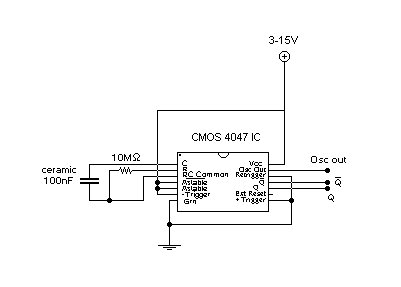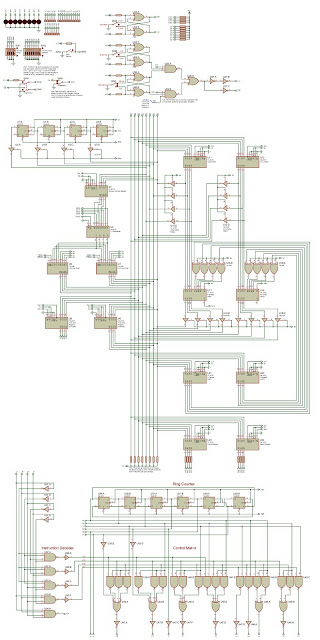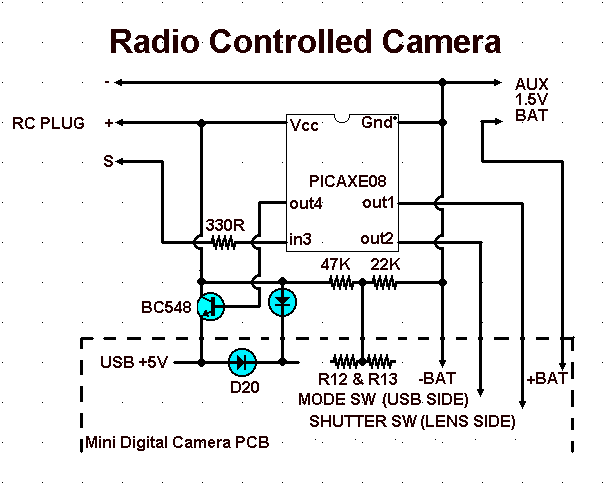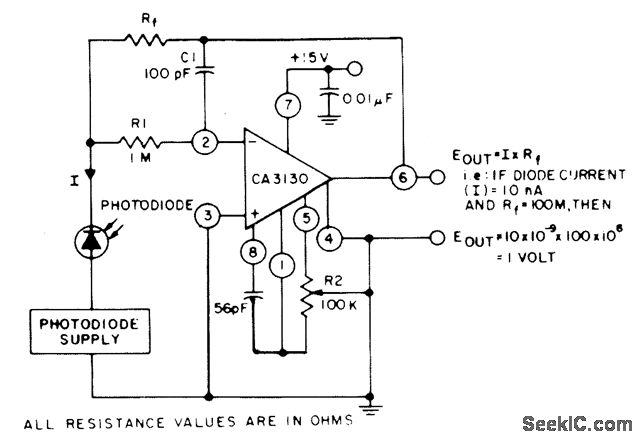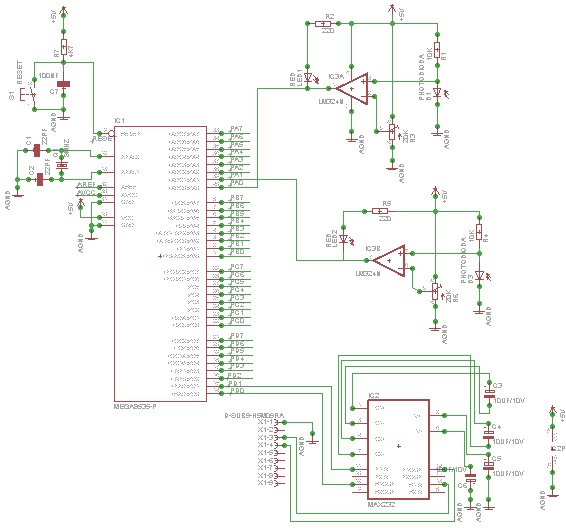
51 one-chip computer ADC0804 analog to digital converter studies
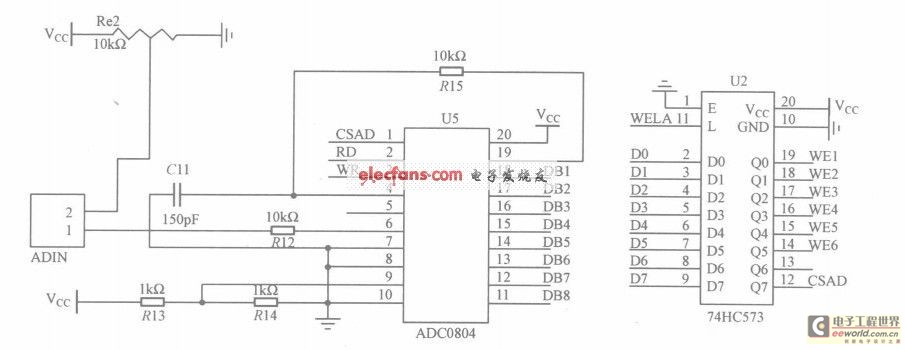
The circuit utilizes the ADC0804, which is configured for left-handed operation, alongside the 74HC573 latch, which is configured for right-handed operation. The latch is connected to a microcontroller, but they are not drawn in the same schematic. The CSAD pin of the ADC0804 functions as a chip selection pin, activated by a low level (0V), allowing it to operate. The RD pin is also active at a low level and serves as the read signal. The WR pin, which is similarly effective at a low level, initiates the A/D conversion process upon receiving a 0V signal. The INTR pin, which is low when set to 0, indicates the completion of the conversion. The digital output is provided through pins DB0-DB7. AGND and DGND serve as ground connections. CLK R and CLK IN, located at pins 19 and 4 respectively, are used to generate the internal clock pulses for the ADC0804, which is connected to an RC oscillating circuit. The input pins 6 and 7 are used for analog signal inputs, such as those from a sliding potentiometer. This setup allows the ADC0804 to function as a mechanically controlled analog-to-digital converter. When the sliding rheostat is adjusted on the breadboard, the resulting digital output is displayed in decimal format on the top three digits of a nixie tube.
The ADC0804 is an 8-bit successive approximation analog-to-digital converter (ADC) that interfaces seamlessly with microcontrollers. It converts an analog voltage signal into a digital representation that can be processed by digital systems. The left-handed configuration of the ADC0804 indicates that the input signals are processed from the left side of the chip, while the right-handed configuration of the 74HC573 latch indicates that the output signals are managed from the right side. The 74HC573 is a high-speed, octal D-type latch that captures data on the rising edge of the clock signal, allowing for precise timing and control of the data flow between the ADC and the microcontroller.
In this circuit, the CSAD pin acts as a gatekeeper, ensuring that the ADC0804 is only active when selected by the microcontroller. The RD pin allows the microcontroller to read the converted digital data from the output pins DB0-DB7. The WR pin initiates the conversion process, signaling the ADC to begin sampling the analog input voltage. The INTR pin provides feedback to the microcontroller, indicating when the conversion is complete and the data is ready to be read.
The ground connections, AGND and DGND, are critical for stable operation, ensuring that all components share a common reference voltage. The clock signals provided by CLK R and CLK IN are essential for the timing of the ADC0804's internal processes. The RC oscillating circuit connected to these clock pins generates the necessary clock pulses to synchronize the ADC's operations.
The analog input to the ADC0804 can come from various sources, with the sliding potentiometer being a practical example. As the potentiometer is adjusted, it varies the voltage level fed into the ADC, which is then converted into a digital value. This digital output can be displayed on a nixie tube, providing a visual representation of the analog input in decimal format. The combination of these components allows for a versatile and effective analog-to-digital conversion system suitable for various applications in electronic design.It is ADC0804 to be left-handed, it is 74HC573 latch to be right hand, the latch connected the one-chip computer and has not drawn at the same time. The pin CSAD of ADC0804 is a chip selection pin because acted as effectively by the low level Hand over 0 hour, we can choose it to work.
RD is that the low level is effective too, it is the read sign al one, WR is that the low level is effective too, can start A/D to begin to be changed when giving 0. INTR is changed and formed One bunch of pins, it is that the low level is effective too, when INTR is 0, represent the end of conversion.
DB0-DB7 is a digital signal output port after changing. AGND and DGND are earthy. CLK R and CLK IN namely 19 and 4 pins Used for, it gives ADC0804 to be pulsing to produce the internal clock Have connected a RC oscillating circuit 6, and 7 port input end of analog signal such as we slip potentiometer on This following procedure carries on the analog to digital converter with the one piece mechanically controlled ADC0804, acts as and twists the potentiometer a slide rheostat on the breadboard When, the digital quantity after the dynamic display A/D in decimal system way of the top three of the nixie tube is changed. The code is as follows: 🔗 External reference
The ADC0804 is an 8-bit successive approximation analog-to-digital converter (ADC) that interfaces seamlessly with microcontrollers. It converts an analog voltage signal into a digital representation that can be processed by digital systems. The left-handed configuration of the ADC0804 indicates that the input signals are processed from the left side of the chip, while the right-handed configuration of the 74HC573 latch indicates that the output signals are managed from the right side. The 74HC573 is a high-speed, octal D-type latch that captures data on the rising edge of the clock signal, allowing for precise timing and control of the data flow between the ADC and the microcontroller.
In this circuit, the CSAD pin acts as a gatekeeper, ensuring that the ADC0804 is only active when selected by the microcontroller. The RD pin allows the microcontroller to read the converted digital data from the output pins DB0-DB7. The WR pin initiates the conversion process, signaling the ADC to begin sampling the analog input voltage. The INTR pin provides feedback to the microcontroller, indicating when the conversion is complete and the data is ready to be read.
The ground connections, AGND and DGND, are critical for stable operation, ensuring that all components share a common reference voltage. The clock signals provided by CLK R and CLK IN are essential for the timing of the ADC0804's internal processes. The RC oscillating circuit connected to these clock pins generates the necessary clock pulses to synchronize the ADC's operations.
The analog input to the ADC0804 can come from various sources, with the sliding potentiometer being a practical example. As the potentiometer is adjusted, it varies the voltage level fed into the ADC, which is then converted into a digital value. This digital output can be displayed on a nixie tube, providing a visual representation of the analog input in decimal format. The combination of these components allows for a versatile and effective analog-to-digital conversion system suitable for various applications in electronic design.It is ADC0804 to be left-handed, it is 74HC573 latch to be right hand, the latch connected the one-chip computer and has not drawn at the same time. The pin CSAD of ADC0804 is a chip selection pin because acted as effectively by the low level Hand over 0 hour, we can choose it to work.
RD is that the low level is effective too, it is the read sign al one, WR is that the low level is effective too, can start A/D to begin to be changed when giving 0. INTR is changed and formed One bunch of pins, it is that the low level is effective too, when INTR is 0, represent the end of conversion.
DB0-DB7 is a digital signal output port after changing. AGND and DGND are earthy. CLK R and CLK IN namely 19 and 4 pins Used for, it gives ADC0804 to be pulsing to produce the internal clock Have connected a RC oscillating circuit 6, and 7 port input end of analog signal such as we slip potentiometer on This following procedure carries on the analog to digital converter with the one piece mechanically controlled ADC0804, acts as and twists the potentiometer a slide rheostat on the breadboard When, the digital quantity after the dynamic display A/D in decimal system way of the top three of the nixie tube is changed. The code is as follows: 🔗 External reference
